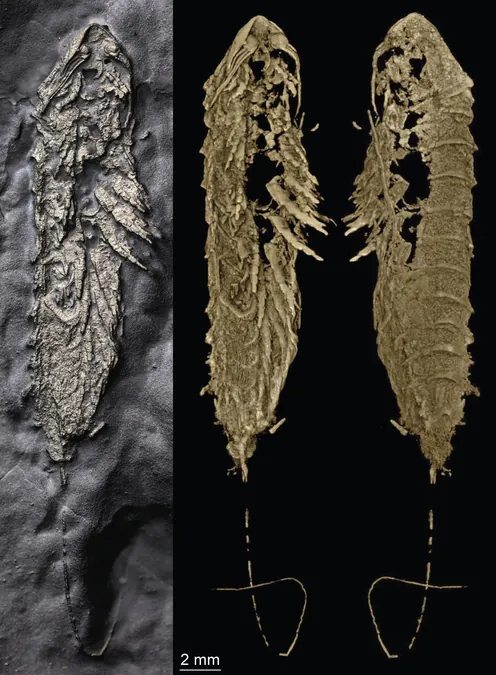
Unearthing Marvels: New Fossil Arthropod Discovered in Fool's Gold!
2024-10-29
Author: Li
A Remarkable Discovery
A remarkable scientific breakthrough has emerged from the Department of Earth Sciences at the University of Oxford, as a team led by Associate Professor Luke Parry unveiled a stunning fossil arthropod estimated to be 450 million years old. This extraordinary specimen, known as Lomankus edgecombei, is not just visually striking but is also completely preserved in fool’s gold, or pyrite—a dazzling revelation for the paleontological community!
Publication and Significance
Published in the esteemed journal Current Biology, this discovery sheds light on an enigmatic chapter of evolutionary history. "These fossils, with their beautiful golden hue, look as if they could just leap back to life at any moment," commented Parry, marveling at the preservation quality.
Classification and Evolutionary Insights
Lomankus edgecombei is classified under a group of arthropods called megacheirans, often referred to as “great appendage” arthropods due to their distinctively large front limb, which they originally used for seizing prey. While many megacheirans flourished during the Cambrian Period (approximately 538–485 million years ago), they were believed to have dwindled by the subsequent Ordovician Period (485–443 million years ago). However, the discovery of Lomankus challenges that notion, indicating that these fascinating creatures continued to diversify well into later geological periods.
Unique Features of Lomankus
What truly sets Lomankus apart is its highly modified appendage. Unlike its ancestors, which used their imposing limbs for predation, Lomankus has evolved a more delicate structure with three long, whip-like flagella, suggesting a shift toward environmental sensing rather than hunting. Such adaptations reveal a completely different ecological niche than that of its Cambrian relatives.
Ecological Speculations
Interestingly, Lomankus appears to lack eyes, hinting that it thrived in the darker, low-oxygen niches of its habitat, depending on its modified appendage for navigation and food detection. Professor Parry noted, "This evolution showcases that megacheirans were not a 'dead end,' but rather, they adapted and flourished in ways we are just beginning to understand."
Fossil Location and Geological Significance
The fossil, unearthed in New York’s "Beecher's Trilobite Bed," is part of a rock layer known for its remarkable fossil fauna, particularly trilobites. This discovery is especially significant as it demonstrates the rare occurrence of other species preserved at this famed site, offering profound insights into life in ancient oceans.
Process of Preservation
Fossils from this location benefited from a unique set of geological conditions that allowed pyrite to replace organic material shortly after burial, creating golden 3D fossils. This process preserves intricate anatomical structures, leading to significant findings regarding early arthropod evolution. "These unique fossils showcase rapid mineral replacement, essential for studying the intricate evolution of early marine life," explained Professor Derek Briggs from Yale University, a co-author of the study.
Conclusion and Future Implications
This exciting discovery not only expands our understanding of extinct species but also poses fundamental questions about the evolutionary lineage of living arthropods today. As researchers continue to dig deeper into Earth’s past, who knows what other riveting secrets await beneath the surface? Stay tuned, as the story of life on our planet continues to unfold in unprecedented ways!







 Brasil (PT)
Brasil (PT)
 Canada (EN)
Canada (EN)
 Chile (ES)
Chile (ES)
 España (ES)
España (ES)
 France (FR)
France (FR)
 Hong Kong (EN)
Hong Kong (EN)
 Italia (IT)
Italia (IT)
 日本 (JA)
日本 (JA)
 Magyarország (HU)
Magyarország (HU)
 Norge (NO)
Norge (NO)
 Polska (PL)
Polska (PL)
 Schweiz (DE)
Schweiz (DE)
 Singapore (EN)
Singapore (EN)
 Sverige (SV)
Sverige (SV)
 Suomi (FI)
Suomi (FI)
 Türkiye (TR)
Türkiye (TR)